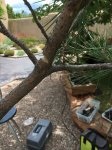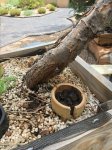PiñonJ
Omono
I collected this Ponderosa in the mountains last year, did its first structural setting yesterday.
Last year, end of may:



Yesterday:

I wanted to do a big trunk bend, so I did a wedge cut and placed a guy wire. I should have placed the cut a little higher, so I could get the saw in at a better angle to make the two sides exactly the same length, but it worked out pretty well.

Screw to attach the guy wire:

Guy wire in place:

Last year, end of may:



Yesterday:

I wanted to do a big trunk bend, so I did a wedge cut and placed a guy wire. I should have placed the cut a little higher, so I could get the saw in at a better angle to make the two sides exactly the same length, but it worked out pretty well.

Screw to attach the guy wire:

Guy wire in place:


















